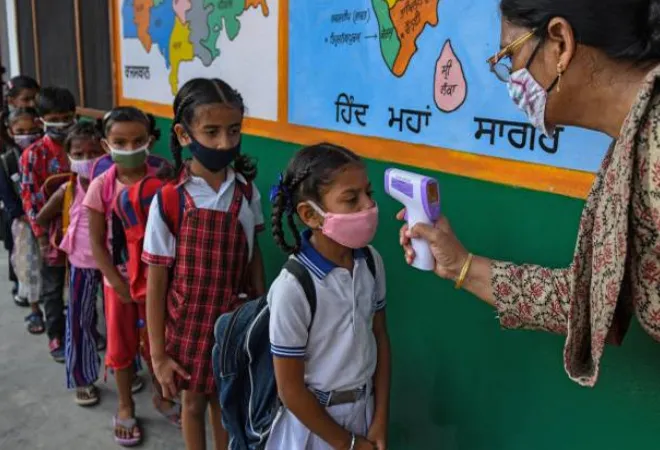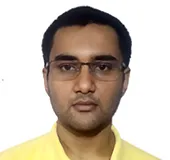 This article is part of the series Children and the Pandemic: An Analysis Across Countries
This article is part of the series Children and the Pandemic: An Analysis Across Countries
Extant
research across the globe indicate that the pandemic has had a comparatively milder impact on the health of infected children and adolescents compared to other age groups. Though this
inference from the available data may be true, one cannot deny the adverse effect of the pandemic on the physical, mental, and emotional well-being of children during the periods of lockdown, which has impacted the larger student community across the globe over the past year-and-a-half. With the second wave of the pandemic now slowing down in India, states have started reopening schools and colleges in a phased manner in an attempt to bring students back to school and to ensure the holistic well-being of children, which includes aspects of mental health, educational gains, and socio-economic learning opportunities. However, as schools reopen across many states, there also has been a significant amount of debate surrounding the plausibility of opening schools amidst a situation where the population below the age of 18 years remains yet to be vaccinated. The piece attempts to delve into the pros and cons of such steps as news of a third wave from developed countries around the world flow in.
The pros
Re-opening schools in a country of India’s size and diversity has become more of a necessity as time passes by. A significant proportion of the student population across rural India come from areas that either face lack of access to high-speed internet or from households that cannot afford a smartphone, resulting in their inability to access education through digital media. More than 50 percent of the students in urban and rural areas across
the country still lack access to internet. The impact of closure of offline classes due to COVID-19 is even higher for students who come from
hilly districts and the hinterland of the country.
With the second wave of the pandemic now slowing down in India, states have started reopening schools and colleges in a phased manner in an attempt to bring students back to school and to ensure the holistic well-being of children, which includes aspects of mental health, educational gains, and socio-economic learning opportunities.
A recent
report from UNESCO estimated a learning loss of around two months for each month of students being away from offline classes. Several other reports published by reputed agencies like
McKinsey and the
Asian Development Bank stress on the learning loss that has resulted out of the closure of schools across the world. Despite attempts to take education to students through the online mode using latest technologies, online learning is still a poor substitute to physical presence and more so for students at the primary level. However,
14 state governments now are set to reopen schools across the country as both parents and students are now willing to get back to school with the second wave receding across the country. Medical practitioners across the country have also vouched for opening up of schools based on empirical evidence of the minimum impact of the COVID-19 pandemic on children across the world. Provided certain restrictions and proper protocols are in place, the opening up of schools might give students an opportunity to once again come out of their homes and get back to the traditional way of learning.
The cons
The decision to open schools by various states may seem to be right at this point of time but give our
past experience with the sudden emergence of the second wave in India, the need is for a cautious and calibrated re-opening. Fully vaccinated teachers and staff, proper COVID-19 protocols, and mandatory quarantine facilities at the school premises should be a standard norm before re-opening. However, the most challenging aspect with regards to re-opening schools is not the formulation of standard protocols but devising ways that results in strict adherence to such safety protocols amongst children. Apart from this, students with chronic medical conditions may need extra care once they are back in school. The infrastructure to ascertain these steps are taken, however, may not be omnipresent across schools in India. Government schools in rural areas might find it quite difficult to adhere to the standard norms. Therefore, the government should not opt for a one-size-fit-all approach but rather should devise standard norms based on the various contextual considerations.
Medical practitioners across the country have also vouched for opening up of schools based on empirical evidence of the minimum impact of the COVID-19 pandemic on children across the world.
The way forward
Considering the benefit to risk ratio based on various
research studies that entail extensive analysis on the effect of COVID-19 on children, the efficacy of vaccines, and the social and emotional consequences of not being able to go to school, it seems opening up schools now in phases is a plausible option. But as schools re-open across the country, governments should keep a close watch on the rise in number of cases and monitor the situation very closely. Any signs of a potential rise in cases should lead to immediate closure of schools till the situation normalises again. Lastly, but most importantly, as we navigate through this crisis, schools across the country should now embrace principles of improvement across various parameters that ranges from infrastructure to technology and make themselves future ready. New approaches that can help physical school education become safe again is the need of the hour.
The views expressed above belong to the author(s). ORF research and analyses now available on Telegram! Click here to access our curated content — blogs, longforms and interviews.



 This article is part of the series
This article is part of the series PREV
PREV


